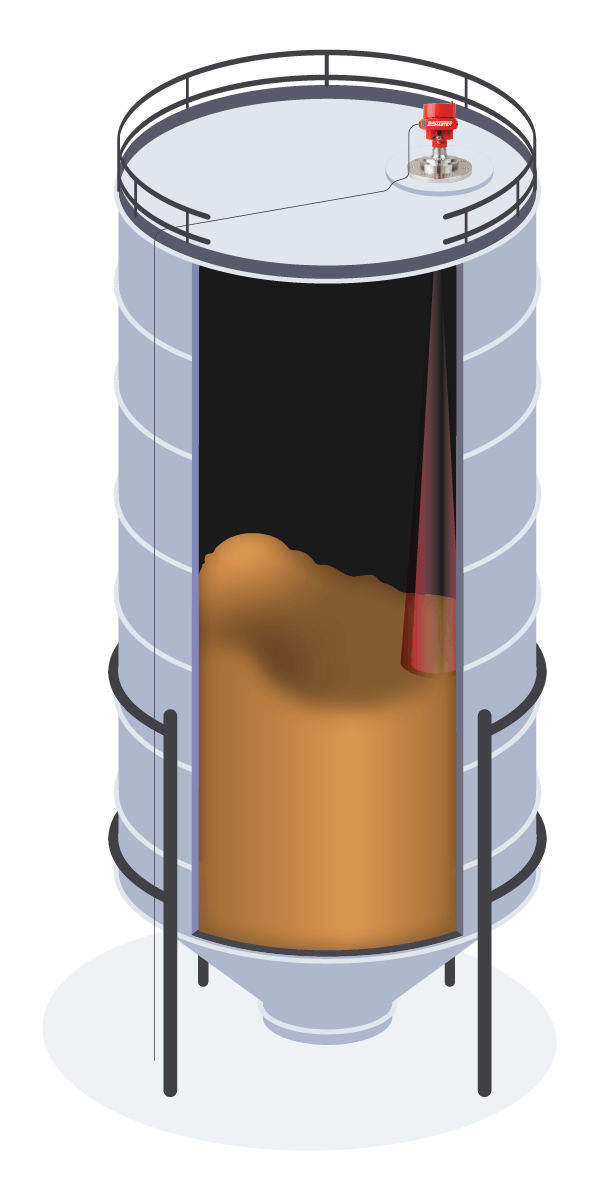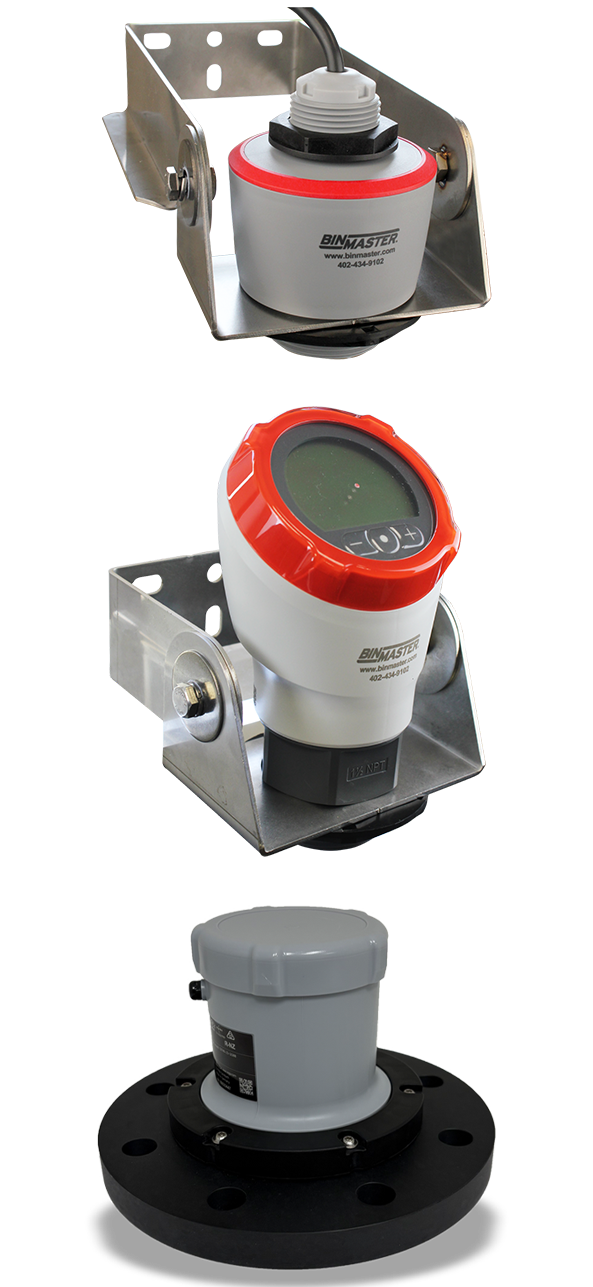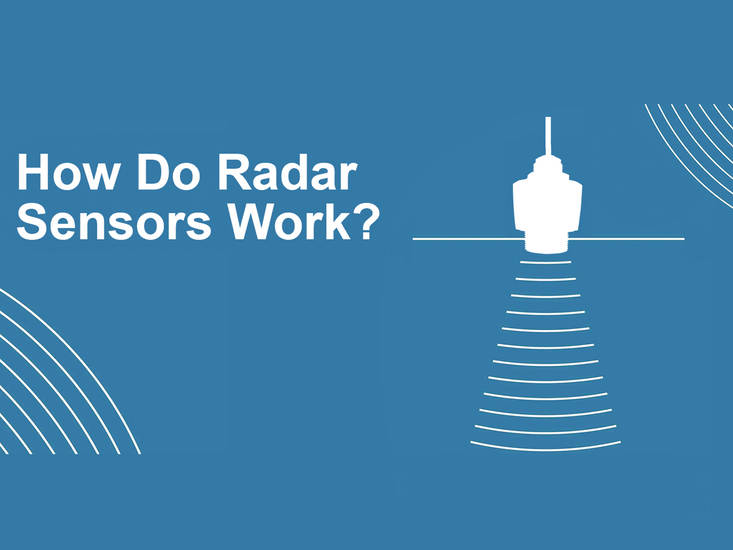How Do Radar Sensors Work?
Want to learn more about how radar measurements work? Curious about radar sensors’ strengths and limitations? You’re in the right place!
Senix’s compact non-contact radar sensors—or CNCRs—utilize an 80 GHz radar signal to gather level measurements of bulk solids and liquids. This signal is sent through the face of the antenna in the form of a beam. It reaches the material surface, where it bounces back, then quickly returns to the CNCR as an echo. 
The sensor internally compares the frequency differences between the initial signal and the echo that it received in return. This difference is converted into measurement data—displayed in the user’s choice of inches, feet, or meters—that represents the distance between the sensor face and the material surface.
But how does the CNCR know how tall the vessel is in the first place? During sensor setup, it doesn’t matter whether the vessel is full, empty, or somewhere in between—the user can easily program the height of their bin, tank, or silo into the sensor.
After a measurement is calculated, it is delivered to the user’s IoT solution of choice, whether that be a local display, PLC, or BinCloud® bulk inventory management software for enhanced inventory control, insights, and interactive reports.
80 GHz radar technology is extremely accurate, and aiming the beam around obstacles or fill points is no problem with the right mounting option—of which there are many. These traits make radar the ideal level sensor for measuring and monitoring bulk solids and liquids in vessels of just about any size or shape.
Its applications fall into measurement of liquids or solids within compact, remote, or hard-to-access bins, tanks, silos, and hoppers:
Bulk Liquids
Radar is a top choice for measuring liquid levels in tanks or open-air conditions due to its accurate, non-contact measurement method.
Got foam? Condensation? Turbulence in the tank? All of this is no problem for CNCR sensors.
- Agriculture Chemicals: Measure pesticides and fertilizers
- Beer & Brewing: Ensure precise batching and monitor liquid levels in both small and large batch brewing tanks
- Cement Slurries: Monitor tanks containing additives and agents added to cement
- Food & Beverage: For accurate counts of hard-to-measure, opaque, or transparent ingredients
- Industrial & Automotive Fluids: Monitor and maintain levels of oils, fuels, washer fluids, and coolants
- Manufacturing & Processing: Manage and ensure that process water pumps and cooling towers deliver adequate liquid levels
- Livestock Pits: Mounted for level detection to avoid overfills
- Water Treatment: In pumping stations, lagoons, lift stations, and clarifiers
- A great choice alongside ToughSonic® sensors!
Bulk Solids
No bulk solids are off limits. Radar retrieves precise level measurements from heavy or chunky aggregates to plastic pellets, as well as raw and finished grain products.

- Challenging Food Ingredients: Measure fluffy flour, granular sugars, and salts
- Flat Storage & Piles: Measure specific single points on a pile of bulk materials
- Mining: Manage raw and finished ores, or mount over conveyors and moving belts to prevent overloads
- Plastic Manufacturing: Monitor tall resin silos where precise inventory is key
- Power Plants: Receive level measurements for fly ash, wood pellets, and fuel byproducts
How are Radar Sensors Used?
Radar measurements are unaffected by noise, humidity, vapor, fluctuations in temperature, or pressure changes. They penetrate through dust, steam, foam, and even condensation or buildup on the sensor's face.
With an accuracy of ±0.2 in. (5 mm), many users choose radar for their harshest applications due to its durable design and unwavering precision. Radar’s non-contact measurements are suitable for sanitary environments, such as food and pharmaceutical processing.
A radar sensor’s compatibility with BinCloud® software provides twice the benefits, allowing users to harness full control over their inventory. Operators and plant workers can view real-time measurement data on-site and remotely from a PC, tablet, or mobile device. Automated notifications alert key users to critical levels before a costly overfill or shortage. Finally, two-factor authentication and custom roles provide an additional layer of security to keep data safe.
The CNCR is a prime choice for keeping workers safer, as it eliminates the need to climb bins, work over open-air tanks, or take measurements in hazardous confined spaces. Plus, installation is nearly effortless with battery-powered and pigtail-wired models.
CNCR sensors can easily be installed in existing openings with 1.5” NPT threads. A wide range of mounting brackets, plates, and swivel mounts are available to fit the needs of every application.
Precise Radar Sensors from Senix & BinMaster
Radar and ultrasonic sensors are closely affiliated. Sometimes, in applications where a ToughSonic® sensor won’t do the trick, a radar will—and vice versa. They can also be paired together for a comprehensive smart inventory system.
Just as radar and ultrasonic work together, so do Senix and its sister company, BinMaster, a leading manufacturer of level sensors and inventory management software in the United States. To learn more about our wide range of continuous and point level sensors, visit BinMaster.com.
For more information on how Senix can help with your application, contact us at info@senix.com or click here.

